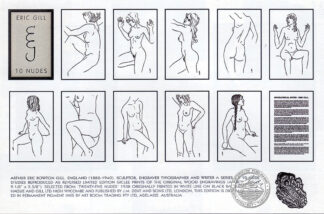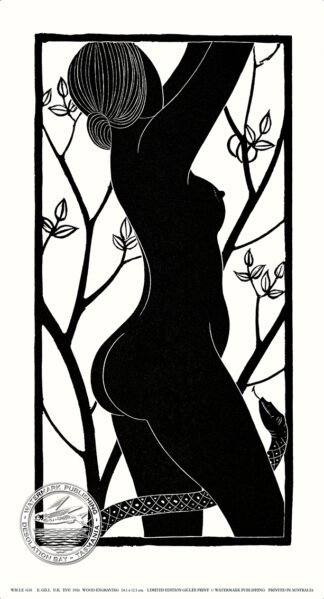GILL, Eric

Sculptor, engraver, typographer and writer. Arthur Eric Rowton Gill was born in Brighton, England in 1882. He was a student at the Chichester Art School, and from 1900-1903 was articled to the architect W.D. Caroe in London. During this period he became interested in lettering and attended the Central School of Arts and Crafts, where he studied under Edward Johnston. He earned his living as a letter-cutter and in 1904 married Mary Ethel Moore and settled in Ditchling, Sussex. Edward Johnston and Hilary Pepler joined him there and he started St.Dominic’s Press. During the next nine years Gill made over 200 engravings, many of which were used several times by Pepler in his publications.
He converted to Roman Catholicism in 1913 and in the following year was commissioned to carve the Stations of the Cross in Westminster Cathedral, a task that took 4 years. After a short spell in the army
Gill returned to Ditchling where he and others formed the Guild of St. Joseph and St.Dominic, a semi religious community for craftsman.
In 1924 he and his family moved to Capel-y-ffin in the Black Mountains of Wales near Abergavenny, where they lived in a former monastery and began his connection with the Golden Cockerel Press of Robert Gibbings and for the Cranach Press of Count Kessler in Weimar. At this time Stanley Morrison asked him to design lettering for the Monotype Corporation, which resulted in the creation of the Perpetua and Sans-serif printing types. He moved to Piggots at Speen, near High Wycombe in Buckinghamshire.
He continued to design printing types, worked on the sculpture for Broadcasting House, London and the League of Nations Building, Geneva. He also travelled to Jerusalem to carve panels for the new museum there.
Gill was appointed R.D.I. in 1936 and A.R.A in 1937. He died at Harefield, Middlesex, in November 1940 and is buried in the churchyard at Speen.
In Drawing from Life, 1940, he writes, “It seems best to draw whatever is natural and normal and trust to the good sense of people to see things in a reasonable manner”. Gill’s interpretation of the natural and normal, however, still causes some of his work to be labelled indecent or erotic.
Showing all 2 results
Showing all 2 results


